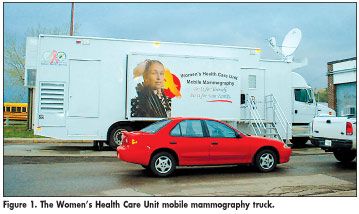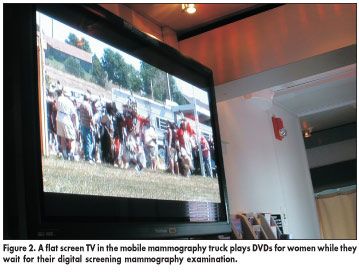Satellite Allows Digital Mammography Screening for Rural Native Americans
A mobile mammography unit that links a digital mammography system with a commercial satellite service provides near real-time interpretation of breast imaging scans to Native American women on remote rural reservations
CHICAGOA mobile mammography unit that links a digital mammography system with a commercial satellite service provides near real-time interpretation of breast imaging scans to Native American women on remote rural reservations, Marilyn Roubidoux, MD, professor of radiology, University of Michigan Health System, said at the 92nd Annual Meeting of the Radiological Society of North America (RSNA) (abstract SSJ01-04) (see Figures 1 and 2).

In the study, digital mammograms were transmitted by satellite from the Aberdeen Area Indian Health Service, Fort Yates, North Dakota, to the University of Michigan Breast Imaging Division in Ann Arbor. Although the size of the mammography image files was extremely large, transmission time averaged only about 5 minutes per file. The mean turnaround time from image transmission to completion of on-line reading was 50 minutes, but as short as 30 minutes when the conditions for satellite communication were ideal, Dr. Roubidoux said. "The results demonstrate that digital mammograms can be transmitted rapidly by satellite without loss of image quality and can be interpreted remotely," she said.

Because of the rapid turnaround from image acquisition to mammography interpretation, patients in need of follow-up were able to obtain additional breast imaging scans while the mobile mammography unit was still in the area: 58 women were called back for further imaging studies, and 42 of them (72%) had repeat scans performed in the mobile unit on the same day or within 1 to 2 days.
"This project demonstrates efforts by the Sioux tribes and the Indian Health Service to overcome obstacles to screening in remote areas and provide better health care to these women," Dr. Roubidoux said.

The study included 515 mammography examinations performed on 506 women. The mobile mammography unit in the study was equipped with a GE Senograph 2000D digital mammography system, which transmitted screening mammograms via satellite to a GE SenoAdvantage 2.0 workstation, where they were immediately interpreted and reported by radiologists. Turnaround time for reporting included the time required for the transmission of images, receipt of a fax containing a clinical history, interpretation of the screening study by a radiologist, preparation of a paper report, and transmission of the report back to the mobile unit by fax.
How Supportive Care Methods Can Improve Oncology Outcomes
Experts discussed supportive care and why it should be integrated into standard oncology care.